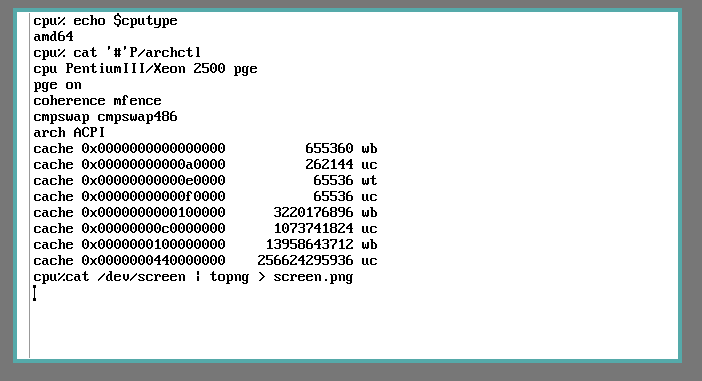LAURA CHAMBERS, CEO, MOZILLA CORPORATION As Mark shared in his blog, Mozilla is going to be more active in digital advertising. Our hypothesis is that we n
That screenshot was actually taken running on bare metal (an old laptop)! Everything works great as long as you don’t need a modern web browser or WiFi for anything. I’ve also gotten it running on a bunch of other random hardware I’ve had laying around, it’s very portable and works fairly well on everything I’ve messed around with so far. I’m also currently waiting for my 10 gig NIC to arrive so I can use an old machine running 9 I have laying around as a router!
You’ll definitely not be doing any hardware accelerated graphics shenanigans on 9, there isn’t really any graphics drivers or anything of that sort, you just get a basic framebuffer and a library to draw basic 2D graphics which can still be plenty if you do some old school software rasterization.
For hardware support you can see an incomplete list for 9front here: https://fqa.9front.org/fqa3.html I’d say you’re probably safe to just pick up an old Dell Optiplex and some cheap generic USB peripherals and it’d probably work out of the box. I’d just double check the Ethernet situation so you can have networking since that’s kind of the whole appeal of 9. Raspberry Pis are also supported and work fairly well in my testing and 9front provides images for them on their website.
I’ve also been working on a software rasterizer for 9! Maybe I’ll post some screenshots here after I polish it up a bit more, lol. I got inspired after porting Quake 1 (I’m aware a port already exists, but I was bored and wanted to reinvent the wheel as a learning experience) and realizing how well it ran. Like, the Quake software renderer is seriously cool tech, way way ahead of it’s time!
I would love for there to be a simple way to just interface with a graphics card directly on a low level w/o any vulkan/d3d/opengl crap in between. Just have the kernel map it to a file in /dev and to set it up and make it do stuff you just fopen() that file and write commands to it.
I wouldn’t be too worried about it honestly, I doubt anyone is scanning the internet to mess with public 9 machines. If you’re worried, just shove them on their own VLAN to keep them separate from the rest of your network.
Retvrn. Are there any other fellow Hexbear 9 enjoyers?
Can we go back to terminals like this?
Right? I’d love to get my hands on an East German Robotron PC 1715, it just looks so good
deleted by creator
Living in a world where everything is connected and computing resources are shared for the betterment of humanity would be so fucking cool.
The grid will connect the world!
deleted by creator
deleted by creator
That screenshot was actually taken running on bare metal (an old laptop)! Everything works great as long as you don’t need a modern web browser or WiFi for anything. I’ve also gotten it running on a bunch of other random hardware I’ve had laying around, it’s very portable and works fairly well on everything I’ve messed around with so far. I’m also currently waiting for my 10 gig NIC to arrive so I can use an old machine running 9 I have laying around as a router!
deleted by creator
You’ll definitely not be doing any hardware accelerated graphics shenanigans on 9, there isn’t really any graphics drivers or anything of that sort, you just get a basic framebuffer and a library to draw basic 2D graphics which can still be plenty if you do some old school software rasterization.
For hardware support you can see an incomplete list for 9front here: https://fqa.9front.org/fqa3.html I’d say you’re probably safe to just pick up an old Dell Optiplex and some cheap generic USB peripherals and it’d probably work out of the box. I’d just double check the Ethernet situation so you can have networking since that’s kind of the whole appeal of 9. Raspberry Pis are also supported and work fairly well in my testing and 9front provides images for them on their website.
deleted by creator
deleted by creator
I’ve also been working on a software rasterizer for 9! Maybe I’ll post some screenshots here after I polish it up a bit more, lol. I got inspired after porting Quake 1 (I’m aware a port already exists, but I was bored and wanted to reinvent the wheel as a learning experience) and realizing how well it ran. Like, the Quake software renderer is seriously cool tech, way way ahead of it’s time!
deleted by creator
I would love for there to be a simple way to just interface with a graphics card directly on a low level w/o any vulkan/d3d/opengl crap in between. Just have the kernel map it to a file in /dev and to set it up and make it do stuff you just fopen() that file and write commands to it.
deleted by creator
I wouldn’t be too worried about it honestly, I doubt anyone is scanning the internet to mess with public 9 machines. If you’re worried, just shove them on their own VLAN to keep them separate from the rest of your network.
deleted by creator
I have it running on a x86_64 Pentium III server; works great!
There are 64-bit Pentium IIIs?
yep! (otherwise my server has a lot of explaining to do)
⑨front user here!